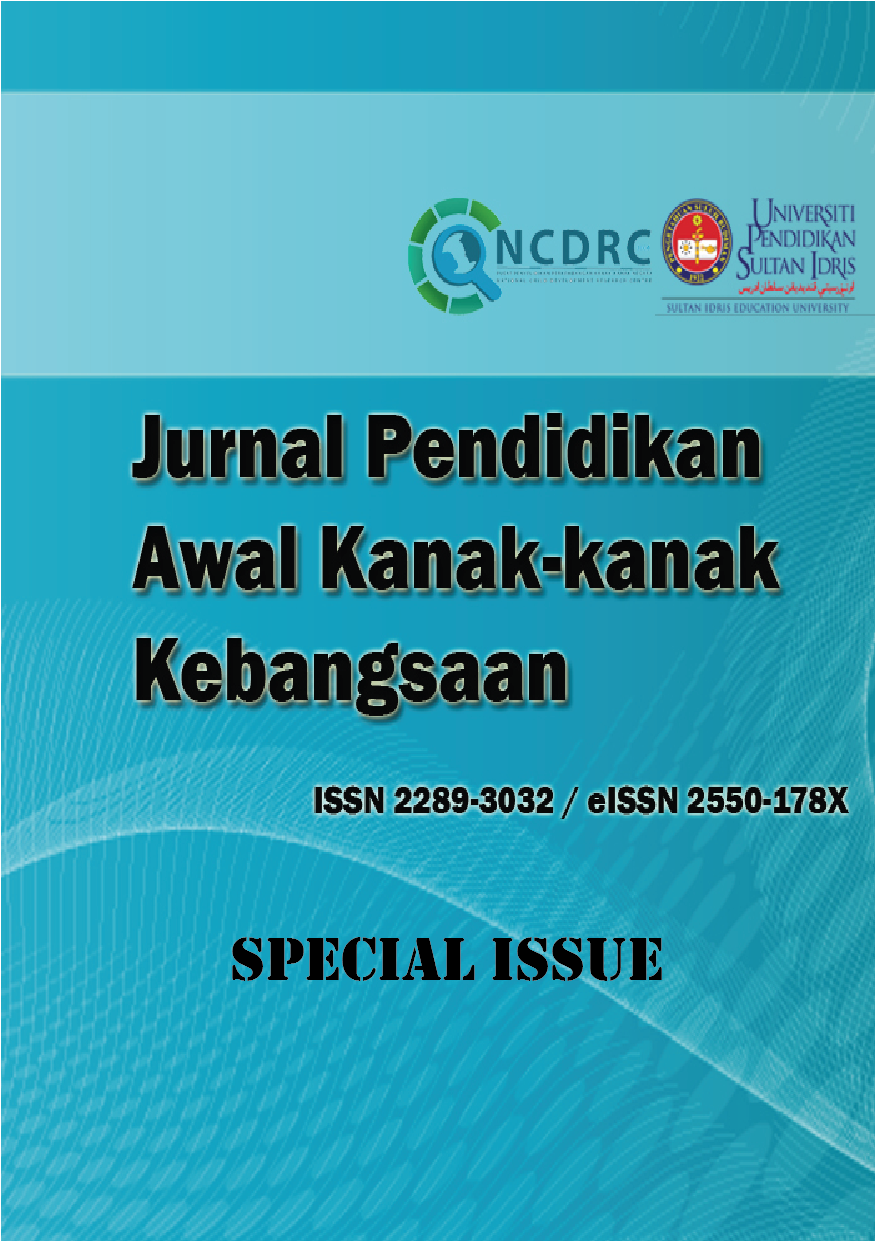Improving Children’s Confidence Through Storytelling
DOI:
https://doi.org/10.37134/jpak.vol11.sp.10.2022Keywords:
children’s confidence, storytellingAbstract
Self-confidence is an important aspect for children to have in Early Childhood Education (ECE). Having self-confidence can help children to fully involve and engage in the playing and learning process. This research aims to examine how storytelling activity can improve children’s confidence by providing numerous learning activities. The design of the study is classroom action research that consists of two cycles. Meanwhile, the participants of the study are 20 children who are 4-6 years old attending a public kindergarten in Kendari, Southeast Sulawesi, Indonesia. This action research has four steps, planning, action, observation and reflection in conducting the study, at the same time, data collection techniques used in this classroom action research consisted of interviews, observation and documentation. Children’s self-confidence was divided into four categories, namely Undeveloped equals to 1; Starting to Develop equals to 2; Developed as Expected equals to 3, Very Well-Developed equals to 4. The results show that through storytelling children have improved their self-confidence as shown in the initial observation only 25% to 64% and 92% respectively in the first and second cycle. In the second cycle, 10 out of 11 aspects are achieved such as children listen well to the teacher deliver learning materials about the question and answer activities; and children can show a friendly attitude both to the teacher and their peers. The increase is also influenced by the teacher’s ability to modify the learning as well as to link children’s experiences into the story.
Downloads
References
Altrichter, H., Feldman, A., Posch, P., & Somekh, B. (2013). Teachers investigate their work: An introduction to action research across the professions, second edition. In Teachers Investigate their Work: An Introduction to Action Research across the Professions, Second Edition. https://doi.org/10.4324/9781315811918
Ardini, P. P. (2015). Pengaruh Dongeng dan Komunikasi Terhadap Perkembangan Moral Anak Usia 7-8 Tahun. Jurnal Pendidikan Anak, 1(1). https://doi.org/10.21831/jpa.v1i1.2905
Benchekroun, R., Cameron, C., & Marmot, A. (2020). Practitioner wellbeing and the physical environment in early childhood education and care ( ECEC ) settings Literature review July 2020. (July), 1–20.
Cavanaugh, D. M., Clemence, K. J., Teale, M. M., Rule, A. C., & Montgomery, S. E. (2017). Kindergarten Scores, Storytelling, Executive Function, and Motivation Improved through Literacy-Rich Guided Play. Early Childhood Education Journal, 45(6), 831–843. https://doi.org/10.1007/s10643-016-0832-8
Cramer, P. (2018). Change in Children’s Self Confidence and the Use of Defense Mechanisms. The Journal of Nervous and Mental Disease. https://doi.org/10.1097/NMD.0000000000000848
Cremin, T., Flewitt, R., Swann, J., Faulkner, D., & Kucirkova, N. (2018). Storytelling and story-acting: Co-construction in action. Journal of Early Childhood Research, 16(1), 3–17. https://doi.org/10.1177/1476718X17750205
Depdiknas. 2004. Pedoman Penilaian Di Taman Kanak-Kanak. Jakarta: Depdiknas.
Jaya, V. A. N. (2016). Pengembangan Multimedia Digital Storytelling sebagai Sarana Penunjang Proses Pembelajaran pada Tema Makananku Sehat dan Bergizi di SD Negeri 12 Purwodadi. (Doctoral Dissertation, Universitas Negeri Semarang).
Juniarti, F. (2018). Meningkatkan Percaya Diri Anak Pada Aspek Kognitif Dengan Metode Bercerita. Jurnal Tunas Siliwangi.
Lisenbee, P. S., & Ford, C. M. (2018). Engaging Students in Traditional and Digital Storytelling to Make Connections Between Pedagogy and Children’s Experiences. Early Childhood Education Journal. https://doi.org/10.1007/s10643-017-0846-x
Nurani. 2011. Mengenal Kepercayaan Diri Anak Usia Dini. Jakarta. Kencana Prenada Media Group.
O’Neill, B. (2017). There’s a crocodile!”: Training preschool teachers to engage children through interactive oral storytelling. Storytelling, Self, Society. https://doi.org/10.13110/storselfsoci.11.2.0183
Prawistri, A. R. (2013). Upaya Meningkatkan Rasa Percaya Diri Anak Kelompok B Melalui Kegiatan Bermain Aktif di TK Pembina Kecamatan Bantul. Universitas Negeri Yogyakarta.
Santos, R. S. (2018). Improving young learners´ listening skills through storytelling (Doctoral dissertation).
The Wiley Handbook of Action Research in Education. (2019). In The Wiley Handbook of Action Research in Education. https://doi.org/10.1002/9781119399490





